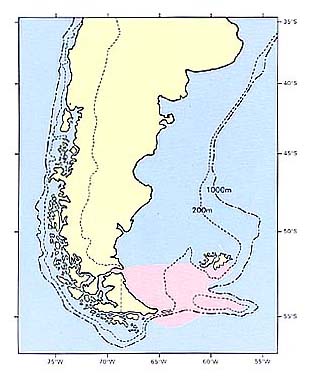コオリウオ科
- HOME
- デジタル図鑑
- パタゴニア海域の重要水族
- 硬骨魚綱 スズキ目
- コオリウオ科
コオリウオ科(Channichthyidae)

(Preserved)
102 ワニクチ(Wanikuchi)
Champsocephalus esox(Günther, 1861)
pike(Arg.); Tsataki(Nombre fueguino)
特 徴:
背鰭9棘-32軟条,臀鰭31軟条,胸鰭23軟条,腹鰭1棘,5軟条,鰓耙数2+10=12,鰓条骨数7。頭長は体長の33.7%,眼径は4.3%,体高は15.5%,吻長は14.9%,両眼間隔は8.4%,上顎長は16.5%,尾柄高は5.1%,胸鰭長は17.1%,腹鰭長は20.6%,第1背鰭高は9.2%,第2背鰭高は6.6%,臀鰭高は6.1%。第1背鰭前長は29.3%,第2背鰭前長は45.6%,胸鰭前長は34.0%,臀鰭前長は52.6%,肛門前長は51.5%,体は延長して,ほっそりしている。頭は大きく,体長は頭長の約3倍。吻は長く,吻長は眼後長よりやや長い。口は大きく,上顎後端は眼の前縁下に達する。一対の鼻孔が眼の直前に位置し,前鼻孔は小円形で,後鼻孔は半月形,両顎歯は微小円錐歯,舌は細長くて平坦,胸鰭は腹鰭より短い。腹鰭は胸鰭よりわずかに前方に位置する。第1背鰭は低く,その基底は短い。第2背鰭と臀鰭の高さは第1背鰭の高さとほぼ同高だが,両者の基底長は第1背鰭基底長よりはるかに長い。尾鰭は小さく,その後縁はわずかに湾入する。側線部を除いて鱗はない。側線は2本あり,上方の側線は主鰓蓋骨上縁上方から尾柄部までの背縁近くを直走し,下方の側線は体の後半部のほぼ体側中央部付近を尾鰭基底部まで直走する。体色は全体に褐色で,不規則な暗色斑点が散在する。
分 布:
フォークランド諸島周辺,マゼラン海峡付近。
備 考:
コオリウオ科の魚類は血液中に赤血球を欠くので,血液は赤くない(DeWitt, 1971)。フォークランド諸島では本種をPikeと呼び,稀にしか食べないが美味とされている(Norman, 1937a)。本種の生息水深は50〜250mで,本種の近縁種でより南に分布するChampsocephalus gunnariは0〜450m(DeWitt, 1971)。
(中村 泉)
Material examened:
I from Argentina(98.2 mm SL), FAKU AP 242.
Description:
D Ⅸ-32; A31; P123; P2 Ⅰ, 5; GR2+10=12; BR7. HL33.7% of SL; ED4.3; BD15.5; SN14.9; PO14.0; IO8.4; UJ16.5; CP5.1; P1L17.1; P2L20.6; D1H9.2; D2H6.6; AH6.1; PreD129.3; PreD245.6; PreP134.0; PreP230.3; PreA52.6; PreAn51.5.
Body slender, elongate. Head large, about 3 times in SL. Snout long, slightly longer than postorbital length of head. Eye small, about 4 times in upper jaw length. Mouth large, its posterior end slightly posterior to anterior margin of eye. Two nostrils situated just anterior to eye, anterior nostril small pore and posterior one crescent. Jaw teeth fine conical. Tongue elongate, flat. Pectoral fin short, shorter than pelvic fin. Pelvic fin situated slightly anterior to pectoral fin. First dorsal fin low, its base short. Heights of second dorsal and anal fins almost as high as height of first dorsal fin their bases long. Caudal fin small, its posterior margin emarginate. No scales except on lateral line. Two lateral lines, upper line originating from upper insertion of opercle and ending at caudal peduncle region, lower line from below posterior 1/3 of second dorsal fin to base of caudal fin. Body brown, irregularly mottled. Up to 35 cm SL.
Distribution:
Falkland region, Straits of Magellan.
Remarks:
The fishes of Channichthyidae lack an oxygen-carrrying pigment in their blood, which appears pale whitish(DeWitt, 1971). Falkland's local name is “Pike" and although rarely eaten, is said to be a good food-fish(Norman, 1937). The depth range is about 50 to 250m. Closely related to C. gunnari is distributed in more southren water, in the depths of 0 to 450 m (DeWitt, 1971).
(Izumi NAKAMURA)

Distribution of Champsocephalus esox in Patagonia.

Gill-rakers (above). Snout (below) with nostrils arrowed.
- 1